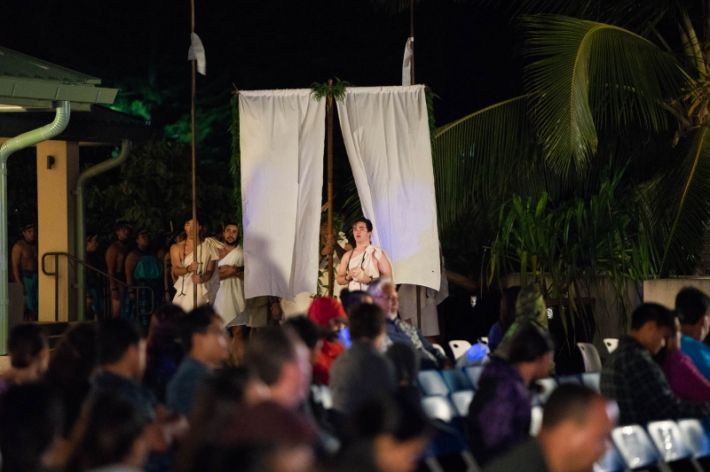Makahiki – the Hawaiian new year – is much more than just playing games. It is a sacred season honoring Lono the god of fertility, agriculture and peace.
Kamehameha Schools Kapālama recently celebrated makahiki at an evening event entitled ‘Aha Makahiki Kapālama. The gathering at Ka‘iwakīloumoku allowed more than 300 students, family members and friends to witness the ceremonial aspects of the four-month season, and strengthened the Native Hawaiian identity of haumāna.
In traditional Hawai‘i, makahiki season began in the fall with a ceremony to build pilina with Lono. High chiefs circled the islands collecting ʻauhau (taxes) and ho‘okupu (offerings) from makaʻāinana (citizens). The offerings included items such as food, cordage and kapa and were given with the hope that Lono would send blessings in the form of rainfall, good growing conditions, and healthy crops.
During the island procession, Lono was represented by the akua loa – a long staff with a Lono carving at its peak. The akua loa had a cross-piece draped in squares of white kapa with palaʻā fern, feather lei, and kaʻupu bird skins fastened near the top.
To honor the traditions of their kūpuna, campus haumāna and kumu began ‘Aha Makahiki Kapālama with a procession, and attendees chanted “O Wāhi Mai ē Lono.” Ka‘iwakīloumoku Manager Jamie Fong said the offerings within the procession had a special connection to the campus.
“The hoʻokupu represented the abundance of the ʻāina,” Fong said. “They were a measure of the labor and industry conducted by those in the ahupuaʻa of Kapālama over the past year.
“Adding to their significance, hoʻokupu were collected from all three schools at Kapālama campus. This means shared kuleana and accountability in the creation of abundance, as well as opportunities for more people to connect to Lono.
“The ipu o Lono (gourd of Lono) was offered to acknowledge the kino lau (body form) of Lono. Ipu have many seeds in them, symbolizing the potential for growth and abundance. Gourds are frequently used for carrying or as storage vessels, again symbolizing surplus or plenty.
“Other hoʻokupu were offered to acknowledge Kapālama as a Hawaiian place of learning. Kukui and lama were given, as they are strong symbols of learning and enlightenment. ‘Lama’ is found in the inoa of the campus – Kapālama.”
Haumāna also gave a ho‘okupu of hula, under the guidance of KS Kapālama Performing Arts Kumu Kaleo Trinidad.
As in ancient times, after the procession was pau, people were free to play games, relax and celebrate a year of hard work. In the case of ‘Aha Makahiki Kapālama, this translated into ‘ono mea ‘ai and musical hoʻokupu by award-winning entertainers Keauhou and Raʻiātea Helm.
“It was great to see lots of haumāna and ʻohana enjoying a nice mix of activities focused on nohona Hawaiʻi – Hawaiian living and learning,” Fong said. “We look forward to an even grander celebration next year!”

To honor the traditions of their kūpuna, campus haumāna and kumu began ‘Aha Makahiki Kapālama with a procession, as attendees chanted “O Wāhi Mai ē Lono.”

KS Cultural Specialist Lāiana Kanoa-Wong (center) reverently receives a hoʻokupu ho’okupu (offerings) collected from all three KS Kapālama schools.
__large-article__www-width-710/jpeg/2753)
Kanoa-Wong and others stand before the akua loa – a representation of the god Lono. Traditionally, the piece included a carving of Lono at its peak, a cross-piece draped in squares of white kapa.

As in ancient times, after the ceremony was pau, people were free to play games, relax and celebrate a year of hard work. In the case of ‘Aha Makahiki Kapālama, this translated into ‘ono eats and a musical hoʻokupu by the award-winning trio Keauhou.

Award-winning vocalist Raʻiātea Helm also shared the gift of mele.
TAGS
sp2020 goal 1,
sp2020 goal 3,
makahiki,
nohona hawai'i,
native hawaiian identity,
ks kapalama
CATEGORIES
Kaipuolono Article, Regions, Themes, Culture, Kapalama Newsroom, Kapalama Home, Newsroom, Campus Programs, Kapalama, Department News, Features, News Briefs
Print with photos
Print text only










